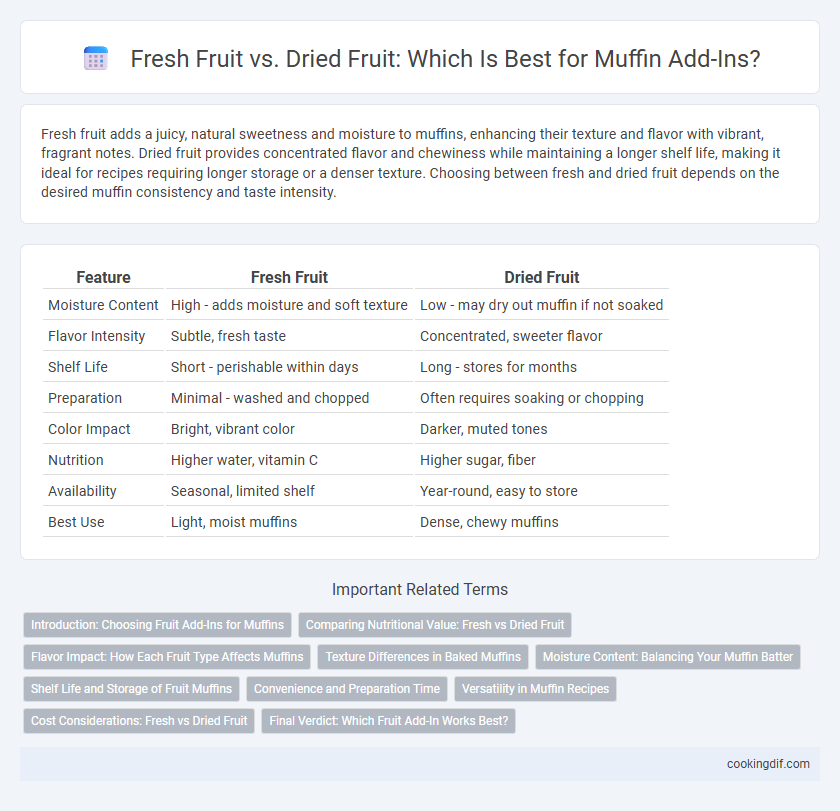Fresh fruit adds a juicy, natural sweetness and moisture to muffins, enhancing their texture and flavor with vibrant, fragrant notes. Dried fruit provides concentrated flavor and chewiness while maintaining a longer shelf life, making it ideal for recipes requiring longer storage or a denser texture. Choosing between fresh and dried fruit depends on the desired muffin consistency and taste intensity.
Table of Comparison
| Feature | Fresh Fruit | Dried Fruit |
|---|---|---|
| Moisture Content | High - adds moisture and soft texture | Low - may dry out muffin if not soaked |
| Flavor Intensity | Subtle, fresh taste | Concentrated, sweeter flavor |
| Shelf Life | Short - perishable within days | Long - stores for months |
| Preparation | Minimal - washed and chopped | Often requires soaking or chopping |
| Color Impact | Bright, vibrant color | Darker, muted tones |
| Nutrition | Higher water, vitamin C | Higher sugar, fiber |
| Availability | Seasonal, limited shelf | Year-round, easy to store |
| Best Use | Light, moist muffins | Dense, chewy muffins |
Introduction: Choosing Fruit Add-Ins for Muffins
Fresh fruit add-ins in muffins provide vibrant moisture and natural sweetness, enhancing texture and flavor with ingredients like blueberries, raspberries, or diced apples. Dried fruit options such as raisins, cranberries, or chopped dates contribute concentrated sweetness and chewy texture without adding extra moisture, making them ideal for longer shelf life. Balancing the type of fruit add-in affects the muffin's overall moisture content, baking time, and crumb structure, making selection critical for desired taste and consistency.
Comparing Nutritional Value: Fresh vs Dried Fruit
Fresh fruit add-ins in muffins provide higher water content and fewer calories, contributing to a moist texture and lower sugar levels, while dried fruit offers concentrated natural sugars and increased fiber per serving. Vitamins like vitamin C remain more intact in fresh fruit, whereas dried fruit delivers a denser source of antioxidants and minerals such as iron and potassium. Choosing between fresh and dried fruit impacts both the nutritional profile and the final taste, with fresh fruit supporting hydration benefits and dried fruit enhancing energy density.
Flavor Impact: How Each Fruit Type Affects Muffins
Fresh fruit adds a juicy burst of natural sweetness and moisture, creating a tender crumb and vibrant flavor in muffins. Dried fruit contributes concentrated sweetness and chewy texture, intensifying the muffin's richness without adding extra moisture. Choosing between fresh and dried fruit directly influences the muffin's overall taste profile and texture, with fresh fruit offering light, refreshing notes and dried fruit delivering deep, robust flavors.
Texture Differences in Baked Muffins
Fresh fruit in muffins provides a moist, tender crumb with bursts of natural juiciness, enhancing the overall softness and lightness of the baked goods. Dried fruit contributes a denser texture and concentrated sweetness, creating a chewy contrast within the muffin. Choosing between fresh and dried fruit significantly impacts the muffin's mouthfeel and moisture retention during baking.
Moisture Content: Balancing Your Muffin Batter
Fresh fruit adds higher moisture content to muffin batter, ensuring a tender, soft crumb and juicy bursts of flavor. Dried fruit contributes concentrated sweetness with less moisture, often requiring adjustments in liquid ratios to maintain optimal batter consistency. Balancing these moisture levels is crucial for achieving perfect muffin texture and preventing sogginess or dryness.
Shelf Life and Storage of Fruit Muffins
Fresh fruit muffins offer a moist texture and vibrant flavor but require refrigeration and have a shorter shelf life of 2-3 days to prevent spoilage. Dried fruit muffins have an extended shelf life of up to one week at room temperature due to lower moisture content, enhancing storage convenience. Proper airtight packaging is essential for both to maintain quality and prevent staleness or mold growth.
Convenience and Preparation Time
Fresh fruit in muffin add-ins offers vibrant flavor and moisture but requires washing, cutting, and careful handling, which increases preparation time and effort. Dried fruit provides convenience with a longer shelf life and no need for chopping or washing, allowing for quick, mess-free mixing. Choosing dried fruit reduces prep time significantly, making it ideal for busy bakers seeking efficiency without sacrificing taste.
Versatility in Muffin Recipes
Fresh fruit adds moisture and vibrant flavors to muffins, enhancing texture and providing natural sweetness tailored to seasonal availability. Dried fruit offers concentrated taste and longer shelf life, making it ideal for year-round baking and consistent texture without excess moisture. Choosing between fresh and dried fruit depends on the desired muffin consistency, flavor intensity, and recipe versatility.
Cost Considerations: Fresh vs Dried Fruit
Fresh fruit typically increases muffin ingredient costs due to higher prices and shorter shelf life, leading to more frequent purchases and potential waste. Dried fruit, while often more expensive per pound, offers longer shelf stability and reduced spoilage, making it cost-effective for bulk buying and storage. Budget-conscious bakers must balance upfront expenses against spoilage risks when choosing between fresh and dried fruit add-ins for muffins.
Final Verdict: Which Fruit Add-In Works Best?
Fresh fruit add-ins provide moistness and vibrant flavor that enhance the soft texture of muffins, while dried fruit contributes concentrated sweetness and chewy texture without adding extra moisture. Choosing between fresh and dried fruit depends on the desired muffin consistency and flavor intensity, with fresh fruit excelling in tenderness and brightness, and dried fruit offering longer shelf life and intensified taste. For optimal results, combining both types can balance moisture and sweetness, creating a complex and satisfying muffin experience.
Fresh fruit vs Dried fruit for muffin add-ins Infographic

 cookingdif.com
cookingdif.com